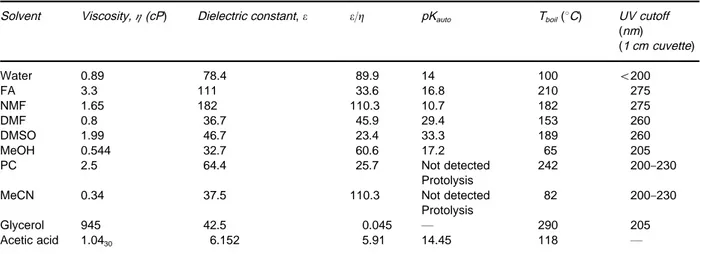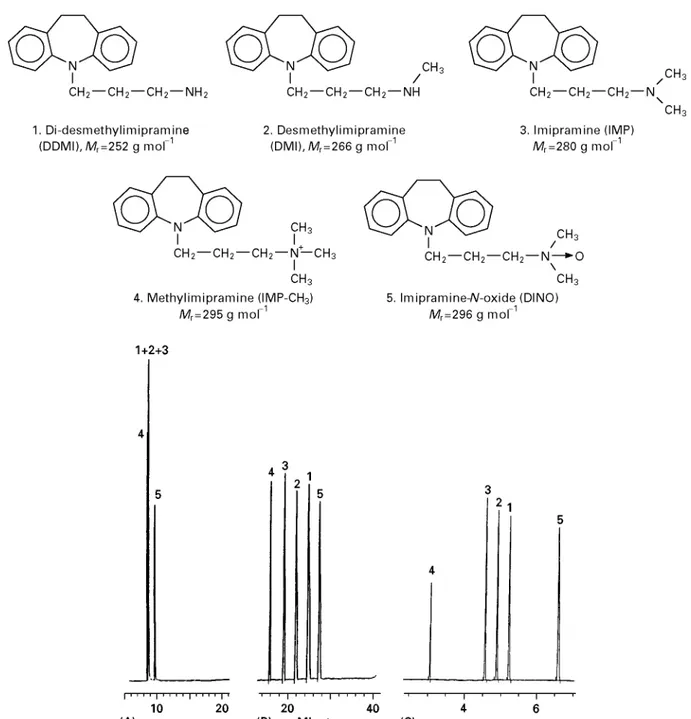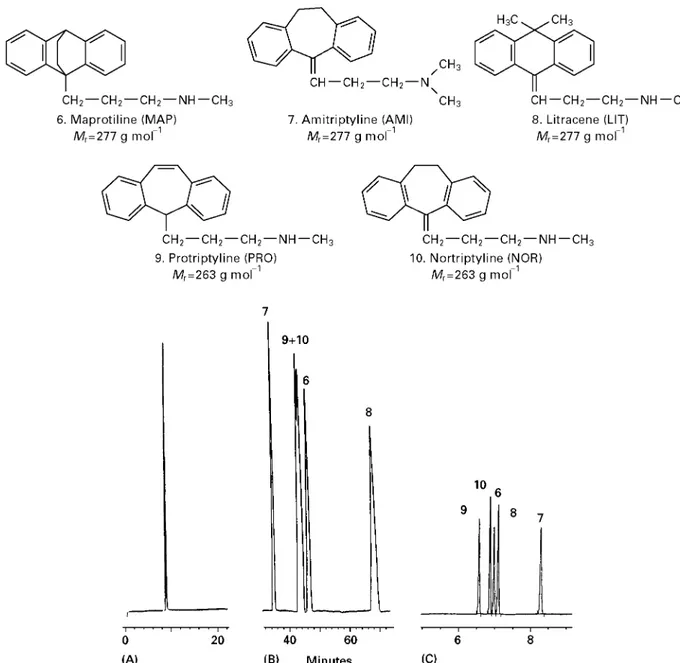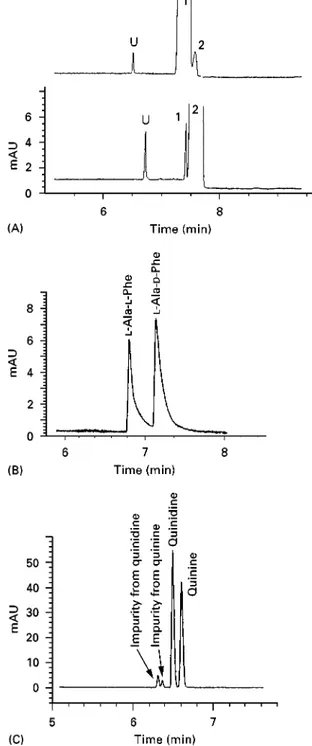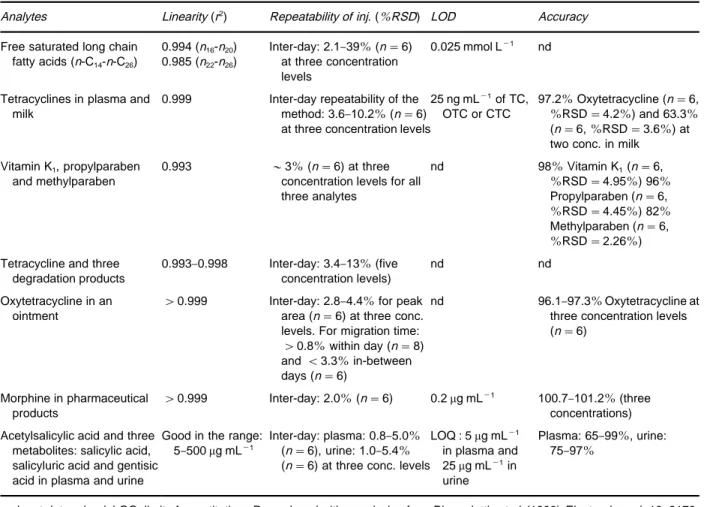to an electrophoretic separation chip is one possible answer. However, there is no reason why reactions cannot be carried out on such devices. Since it does not require the investment of a large chemical plant, the reactions can be performed where required, thus reducing the need to transport hazardous chemicals across countries. Since many reactors can be con-structed on a single chip, and many chips located in the same area, it is evident that this technology will provide hazardous or chemically unstable chemicals where they are required.
Further Reading
Altria KD (ed.) (1996) Capillary Electrophoresis Guide-book,Principles,Operation,and Applications. New Jer-sey: Humana Press.
Harrison DJ and Van den Berg A (eds) (1998)Micro Total Analysis Systems ’98. Dordrecht: Kluwer Academic Publishers.
Haswell SJ (1997) Developments and operating character-istics of microSow injection analysis systems based on electroosmoticSow. Analyst 122: 1Rd1OR.
Manz A and Becker H (1997)Microsystem Technology in Chemical and Life Sciences. Berlin: Springer.
Madou M (1996)Fundamentals of Microfabrication. Boca Raton: CRC.
Martin AJP (1962) Opening lecture. In: Van Swaay M (ed.)
Fourth International Symposium on Gas Chromatogra-phy. London: Butterworths.
Oefner PJ, Bonn GK and Chiesa C (1995)Encyclopaedia of Analytical Chemistry, pp. 1041}1152. London: Aca-demic Press.
Pethig R and Markx GH (1997) Applications of dielec-trophoresis in biotechnology, Trends in Biochemistry
15: 426}432.
Regnier F (1999) The evolution of analysis in life science research and molecular medicine: the potential role for separations. Chromatographia 49: S56dS64.
Tsuda T (ed.) (1995)Electric Field Applications, pp. 47}73. Weinheim: VCH.
Nonaqueous Capillary Electrophoresis
S. H. Hansen, I. Bj[rnsdottir and J. Tj[rnelund,
Royal Danish School of Pharmacy, Copenhagen, Denmark
Copyright^ 2000 Academic Press
Electrophoresis is a separation technique that is nor-mally performed in an aqueous environment. This is due to the fact that the separation mechanism is based on the difference in migration rate of charged species in an electric Reld. Species (ions/molecules or par-ticles) with a difference in their charge over size ratio will exhibit a difference in migration rate. Most charged species are fairly soluble in aqueous media and thus water is the most obvious solvent for elec-trophoresis. However, in a number of nonaqueous solvent systems, it is possible to obtain sufRcient conductivity to perform electrophoresis. If such sys-tems are utilized with the technique of capillary elec-trophoresis, a number of advantages compared to aqueous systems are obtained in the separation of small molecules. Nonaqueous electrophoresis of bi-opolymers like polysaccharides, nucleic acids and proteins is not of practical use due to lack of solubility of such molecules in organic solvents.
Nonaqueous Capillary Electrophoresis
Only a few attempts to perform nonaqueous paper electrophoresis have been described and these articles
were reviewed in 1978. In 1984 nonaqueous capillary electrophoresis (NACE) was brieSy mentioned in a single publication, but not utilized further. How-ever, since 1993 the use of nonaqueous media for capillary electrophoresis has seen renewed interest in the separation of drug substances due to the high separation selectivity obtained in these systems.
The electrophoretic migration of the solutes is
in-Suenced by the nature of the solvent or solvent mix-ture used for the electrophoresis medium in three main ways:
1. The mobility may change due to changes in the size of the solvated ion.
2. The dielectric constant of the organic solvent may inSuence the equilibrium of the protolytic dis-sociation. The higher the value of the dielectric constant, the higher the degree of ionization of acids and bases.
3. The acid}base property of the solute, expressed by its pKa value, may change due to the
differenti-ating effect of many organic solvents.
The latter effect of the three is the most signiRcant, as the dissociation constant, Ka, may change many
orders of magnitude for different solvents.
Table 1 Classification of organic solvents according to their Br+nsted acid}base behaviour
Solvent designation Relative acidity Relative basicity Examples
Neutral # # MeOH, glycerol, phenol, tert, butyl alcohol Amphiprotic Protogenic # ! Sulfonic acid, formic acid,acetic acid
Protophilic ! # Liquid ammonia,FA, NMF
Dipolar protophilic ! # DMSO, DMF, tetrahydrofurane, 1,4-dioxan, pyridine
Aprotic Dipolar protophobic ! ! MeCN, acetone, nitrobenzene, sulfolane, PC
Inert ! ! Aliphatic hydrocarbons, benzene,
1,2-dichlorethane, tetrachloromethane
!indicates weaker and#indicates stronger acid or base than water. DMF,N,N-dimethylformamide; DMSO, dimethyl sulfoxide: FA, formamide; MeCN, acetonitrile; MeOH, methanol; NMF,N-methylformamide; PC, propylene carbonate. Solvents in italic are the ones that are preferred for NACE. Reproduced with permission from TjCrnelund J and Hansen SH (1999)Journal of Biochemistry and Biophysical Methods 38: 139}153.
Table 2 Physicochemical parameters of selected solvents
Solvent Viscosity,(cP) Dielectric constant, / pKauto Tboil(3C) UV cutoff (nm)
(1 cm cuvette)
Water 0.89 78.4 89.9 14 100 (200
FA 3.3 111 33.6 16.8 210 275
NMF 1.65 182 110.3 10.7 182 275
DMF 0.8 36.7 45.9 29.4 153 260
DMSO 1.99 46.7 23.4 33.3 189 260
MeOH 0.544 32.7 60.6 17.2 65 205
PC 2.5 64.4 25.7 Not detected
Protolysis
242 200}230
MeCN 0.34 37.5 110.3 Not detected
Protolysis
82 200}230
Glycerol 945 42.5 0.045 * 290 205
Acetic acid 1.0430 6.152 5.91 14.45 118 *
All values are at 253C unless otherwise stated in subscript. For abbreviations, see Table 1. Reproduced with permission from TjCrnelund J and Hansen SH (1999)Journal of Biochemistry and Biophysical Methods 38: 139}153.
strong acids or bases are dissolved in water, they all show up with about the same acid or base strength. If the same acids or bases are dissolved in organic sol-vents they will exhibit very different protolytic behav-iour depending on the degree of dissociation, which again depends on the solvent in question.
Important factors inSuencing the choice of organic solvent or solvent mixture for a given separation are volatility, the dissolving power towards suitable elec-trolytes, viscosity and dielectric constant, UV trans-parency and, last but not least, the effect on the separation selectivity of the system. Information on the viscosity and volatility, the auto protolysis con-stant, the dielectric constant at standard conditions and the UV transparency of the neat solvents may be found in the literature. In contrast, data on solvent mixtures and systematic studies of how to choose solvents and electrolytes in order to control the selectivity of the electrophoretic system are limited
and thus the choice of separation media is still a mat-ter of trial and error. Solvents may be classiRed ac-cording to their Br+nsted acid}base behaviour; a sim-pliRed version of this classiRcation is shown in
Table 1.
Practical Considerations
Choice of Organic SolventFigure 1 Electropherograms of imipramine and four derivatives. (A) 50 mmol L\16-aminocaproic acid pH 4.0; (B) 50 mmol L\1 6-amino caproic acid pH 4.0 with 25 mmol L\1of 3-(N,N-dimethylmyristylammonium) propanesulfonate and 15 mmol L\1of Tween威20 added. Apparatus: Quanta 4000. Conditions: 64 cm (56 cm to the detector);75m i.d. capillary, hydrostatic (10 cm) injection for 15 s, ambient (27}303C), 20 kV (62A) and UV detection at 214 nm. (C) 25 mmol L\1ammonium acetate and 1 mol L\1acetic acid in acetonitrile. Apparatus: HP3DCE instrument. Conditions: 64 cm (55.5 cm to the detector);50m i.d. capillary, injection of 3 s at 5 kPa (50 mbar), 253C, 25 kV (7A) and UV detection at 214 nm. Adapted with permission from BjCrnsdottir I, TjCrnelund J and Hansen SH (1996) Selectivity enhancement in capillary electrophoresis using nonaqueous media.Journal of Capillary Electrophoresis 3: 83}87.
Solvents with a high vapour pressure and thus a high volatility (e.g. methanol (MeOH) and aceto-nitrile (MeCN)) may be inconvenient for automated analysis in some instruments due to problems with evaporation of the electrophoresis medium from the
sol-Figure 2 Electropherograms of five basic drugs with equal or very similar mass over charge ratio. (A) 50 mmol L\16-aminocaproic acid pH 4.0; (B) 50 mmol L\16-amino caproic acid pH 4.0 with 25 mmol L\1of Tween威20 added. Apparatus and conditions as in Figure 1A. (C) 25 mmol L\1ammonium acetate and 100 mmol L\1sodium acetate in methanol#acetonitrile (1 : 1 v/v) and 25 kV (23A). Apparatus and other conditions as in Figure 1C. Adapted with permission from BjCrnsdottir I, TjCrnelund J and Hansen SH (1996) Selectivity enhancement in capillary electrophoresis using nonaqueous media.Journal of Capillary Electrophoresis 3: 83I87.
vents have a UV cutoff at 214 nm or above (Table 2). Nevertheless, solvents like MeCN and MeOH may be used for measurements performed at a wavelength as low as 200 nm as the light path through the capillary is very short compared to the 1 cm cuvette used for the determination of the UV cutoff wavelength. The amides and dimethylsulfoxide can only be used when detection at wavelengths abovec. 245 nm is sufRcient of the application.
On the positive side, organic solvents often inten-sify the Suorescence relative to what is observed for
given solutes in aqueous media. This has been used to decrease detection limits in NACE for analysis of tetracyclines in biological matrices.
Choice of Electrolyte
Figure 3 Electropherograms ofcis-trans- and diastereo-isomers. (A) Separation ofcis- andtrans-flupenthixol decanoate using 50 mmol L\1 ammonium acetate and 1 mol L\1acetic acid in methanol#acetonitrile (1 : 1, v/v), above:cis-flupenthixol decanoate with 0.5%trans-isomer added; below:trans-flupenthixol decanoate. Conditions: 64 cm (55.5 cm to the detector);50m i.d. capillary, injection for 3 s at 5 kPa (50 mbar), 253C, 30 kV (9A) and UV detection at 230 nm. Test solution:
5.0 mg mL\1of the sample in methanol#acetonitrile (1 : 1 v/v). Peak identity: 1,cis-flupenthixol decanoate; 2,trans-flupenthixol decanoate; U, unknown. (B) Separation of dipeptides (diastereomers); (C) separ-ation of quinine and quinidine (diastereomers). Conditions as in (A) with a detection wavelength of 214 nm. Adapted with permission from Han-sen SH, BjCrnsdottir I and TjCrnelund J (1997) Separation of cationic cis-trans(Z-E) isomers and diastereomers using nonaqueous capillary electrophoresis.Journal of Chromatography A792: 49}55.
a good solvating power towards the electrolytes com-monly used in NACE. So far, ammonium acetate has been the most frequently used electrolyte in NACE systems and acetic acid or sodium acetate have often been used in combination with ammonium acetate in order to adjust the acid}base properties of the electrophoresis medium. Quaternary ammonium salts have also been used a number of times with success, e.g. in the separation of phenols and car-boxylic acids. More rarely, Tris, magnesium acetate, citric acid, formic acid, triSuoroacetic acid and methanesulfonic acid have been used.
When coupling CE to mass spectrometry (MS), it is an advantage to choose a volatile electrolyte, e.g. ammonium acetate, in order to limit background noise or cluster ion formation.
Other Additives
A number of polyalcohols and surfactants such as the Tweens威 have been used as additives. Their primary function is to decrease the electroosmotic
Sow (EOF) and thus prolong the time for elec-trophoretic separation.
Also chiral separations are possible in NACE using either cyclodextrines or chiral counter ions as additives.
Reversal of EOF
The separation of anionic solutes in CE may lead to extended time of analysis due to their migration in the direction opposite to EOF. One method of decreasing the analysis time is to reverse the EOF, thus making the anions migrate in the same direction as the EOF. In aqueous CE, the addition of long alkyl chain trimethylammonium ions is used for this purpose, e.g. in the analysis of inorganic anions and phenols. This principle may also be used in NACE. However, the long alkyl chain trimethylammonium ions are not able to form hemimicelles at the inner capillary sur-face when using nonaqueous solvents and thus the EOF is not reversed. Addition of the polycation hexa-dimethrine bromide to the nonaqueous electrophor-esis medium may result in suitable and stable systems with reversed EOF, even when used at fairly low concentrations (0.001}0.05%).
Applicability of NACE
Table 3 Applications of NACE in analysis of food, pharmaceuticals and biological fluids
Solvents Electrolytes Analytes
Applications within food
NMF-dioxane (1 : 1 v/v) 40 mmol L\1Tris, 2.5 mmol L\1 anthraquinone-2-carboxylic acid
Free saturated long chain fatty acids (n-C14-n-C26). Separation of dimeric and trimeric acids and hydrogenated fish oil NMF 500 mmol L\1magnesium acetate
tetrahydrate
Tetracycline (TC), oxytetracycline (OTC), chlorotetracycline (CTC), demeclocycline, 4-epitetracycline, anhydrotetracycline, 4-epianhydrotetracycline, and desmethyltetracycline
TC, OTC and CTC in milk and plasma Propylene carbonate Tetraalkylammonium ions, long chain
trimethylammonium ions 20 mmol L\1tetradecylammonium
bromide (vitamin K1and preservatives)
Phenanthrene,-naphthol, preservatives: methylparaben, ethylparaben and propylparaben, thiourea (EOF marker) and vitamin K1
Applications within pharmaceuticals
10}100%MeOH Ammonium acetate, acetic acid Haloperidol and synthetic putative metabolites, pyrazoloacridine and mifentidine
Mixture of MeOH and H2O Ammonium acetate, acetic acid Haloperidol, cimetropium and mifentidine MeOH 5 mmol L\1ammonium acetate,
100 mmol L\1acetic acid
Haloperidol and its synthetic putative metabolites, pyrazoloacridine and its synthetic putative metabolites, mifentidine and its synthetic putative metabolites MeOH and mixture of MeOH and MeCN Ammonium acetate, tetrabutylammonium
bromide, tetrabutylammonium hydrogen sulfate and tetrapentylammonium bromide
Tamoxifen and four phase I metabolites
MeOH, MeCN, mixture of MeOH and MeCN, formamide, NMF, DMF, DMA, DMSO
25 mmol L\1ammonium acetate,
0}1 mol L\1acetic acid or 100 mmol L\1 sodium acetate
Application: 25 mmol L\1ammonium acetate, 1 mol L\1acetic acid in MeCN
Imipramine, di-desmethylimipramine, desmethylimipramine, methylimipramine and imipramine-N-oxide. Maprotiline, amitriptyline, litracene, protriptyline and nortriptyline. Application: imipramine N-oxide and impurities
MeOH : MeCN : DMF (45 : 49 : 6 v/v/v) 25 mmol L\1ammonium acetate, 10 mmol L\1citric acid and 118 mmol L\1methanesulfonic acid
Tetracycline and three degradation products. Tetracycline, oxytetracycline, doxycycline, desmethyltetracycline and
chlortetracycline MeOH : MeCN (1 : 1 v/v) 20 mmol L\1ammonium acetate,
1 mol L\1acetic acid
Morphine analogues, antihistamines, antipsychotics and stimulants Formamide, NMF or DMF Citric acid or acetic acid mixed with Tris.
Chiral selectors:-CD,-CD and derivatized-CD. Addition of long chain alkyl ammonium salts investigated
Racemic mixtures of chlorphedianol, chlorcyclizine, ethopropazine, mianserin, nefopam, primaquine, propiomezine, trihexyphenidyl, trimeprazine, trimipramine and thioridazine NMF, formamide and mixtures of both 25}200 mmol L\1-CD, 10 mmol L\1NaCl Dansylated amino acids NMF 5}100 mmol L\1-CD and 10 mmol L\1
NaCl
Dansylated amino acids
MeOH Ammonium acetate, acetic acid, quinine N-3,5-dinitrobenzylated amino acids, ($)-1,1-binaphthyl-2,2-diyl hydrogen phosphate and
N-[1-(1-naphthyl)ethyl]phthalomic acid MeCN ($)-Camphorsulfonic acid potassium or
sodium salt, 1 mol L\1acetic acid 0.2 mol L\1Tween 20
Atenolol, bisoprolol, bunitrolol, metroprolol, pindolol, propranolol, salbutamol, ephedrine, epinephrine, cisapride and synthetic impurities
Formamide Tetra-n-butylammonium perchlorate. Chiral selector: (#)-18-crown-6-tetracarboxylic acid
Table 3 Continued
Solvents Electrolytes Analytes
Formamide, NMF, DMF, DMA, DMSO, MeOH, MeCN and mixtures of MeOH and MeCN
25 mmol L\1ammonium acetate, 1 mol L\1acetic acid
Morphine, codeine, normorphine, thebaine, noscapine and papaverine. Application: morphine in opium tincture
MeOH : MeCN (75 : 25) 25 mmol L\1ammonium acetate, 1 mol L\1acetic acid
Morphine
NMF 500 mmol L\1magnesium acetate tetrahydrate
Oxytetracycline in an ointment
Mixtures of MeOH and MeCN Ammonium acetate, ammonium chloride, acetic acid, trifluoroacetic acid, formic acid, methane sulfonic acid
Cis-trans (Z-E) isomers of chlorprothixene, thiothixene, clopenthixol, flupenthixol, flupenthixol decanoate, clomiphene and diastereomers:L-Ala-L-Phe,L-Ala-D-Phe; quinine, quinidine, cinchonine and cinchonidine
Mixtures of MeOH and MeCN Sodium acetate A range of penicillins, cephalosporins and nonsteroidal anti-inflammatory drugs
MeOH 20 mmol L\1CAPS and 0
}40 mmol L\1 Brij 35
Mesoporphyrin, coporphyrin,
pentaporphyrin, hexacarboxylporphyrin, heptacarboxylporphyrin and uroporphyrin
Applications within biological fluids
10}100%MeOH in H2O 20 mmol L\1ammonium acetate, 1%acetic acid
Pyrazoloacridine, two metabolites and a synthetic degradation product in urine NMF 500 mmol L\1magnesium acetate
tetrahydrate
Tetracycline (TC), oxytetracycline (OTC), chlortetracycline (CTC), demeclocycline, 4-epitetracycline, anhydrotetracycline, 4-epianhydrotetracycline and
desmethyltetracycline. TC, OTC and CTC in cow milk and human plasma
MeOH 5 mmol L\1ammonium acetate, 100 mmol L\1acetic acid
Mifentidine and three metabolites in rat liver homogenate
MeOH : MeCN (1 : 1 v/v) 50 mmol L\1ammonium acetate, 159 mmol L\1sodium acetate and 0.002%(w/v) hexadimethrine bromide
Acetylsalicylic acid and three metabolites: salicylic acid, salicyluric acid and gentisic acid in plasma and urine
Reproduced with permission from BjCrnsdottiret al. (1998) Electrophoresis 19: 2179.
NACE provides high separation power of very sim-ilar substances without using additives like surfac-tants or cyclodextrines. InFigures 1and2the separ-ation of very similar substances using NACE are compared to separation in an aqueous CE and a MEKC system. As seen in Figure 2, even substances expected to have identical mass over charge may be separated in a short time compared to the aqueous systems. Figure 3 shows the separation of cis-trans isomers and diastereoisomers. These isomers are also expected to have the same mass over charge ratio. The use of NACE in the analysis of food, pharma-ceuticals and biological Suids has been reviewed by Bj+rnsdottir and co-workers and inTable 3an over-view of applications is given. An important practical consequence of using a NACE separation medium is that the organic phases resulting from either simple extractions or from eluents from solid-phase extrac-tions can be injected directly into the system, thereby saving time.
Furthermore, some NA solvents seem promising for CE-MS experiments due to the volatility of the solvents and the relatively low current generated in the organic solvents. The low current is comparable to the current generated in electrospray MS interfaces and therefore the stability of online CE-MS is optimized.
Table 4 Validation data from quantitative NACE analysis of food, pharmaceuticals and biological fluids
Analytes Linearity (r2) Repeatability of inj. (%RSD) LOD Accuracy
Free saturated long chain fatty acids (n-C14-n-C26)
0.994 (n16-n20) 0.985 (n22-n26)
Inter-day: 2.1}39%(n"6) at three concentration levels
0.025 mmol L\1 nd
Tetracyclines in plasma and milk
0.999 Inter-day repeatability of the method: 3.6}10.2%(n"6) at three concentration levels
25 ng mL\1of TC, OTC or CTC
97.2%Oxytetracycline (n"6,
%RSD"4.2%) and 63.3%
(n"6,%RSD"3.6%) at two conc. in milk
Vitamin K1, propylparaben and methylparaben
0.993 &3%(n"6) at three concentration levels for all three analytes
nd 98%Vitamin K1(n"6,
%RSD"4.95%) 96%
Propylparaben (n"6,
%RSD"4.45%) 82%
Methylparaben (n"6,
%RSD"2.26%)
Tetracycline and three degradation products
0.993}0.998 Inter-day: 3.4}13%(five concentration levels)
nd nd
Oxytetracycline in an ointment
'0.999 Inter-day: 2.8}4.4%for peak area (n"6) at three conc. levels. For migration time:
'0.8%within day (n"8) and(3.3%in-between days (n"6)
nd 96.1}97.3%Oxytetracycline at three concentration levels (n"6)
Morphine in pharmaceutical products
'0.999 Inter-day: 2.0%(n"6) 0.2g mL\1 100.7
}101.2%(three concentrations)
Acetylsalicylic acid and three metabolites: salicylic acid, salicyluric acid and gentisic acid in plasma and urine
Good in the range: 5}500g mL\1
Inter-day: plasma: 0.8}5.0% (n"6), urine: 1.0}5.4% (n"6) at three conc. levels
LOQ : 5g mL\1 in plasma and 25g mL\1in urine
Plasma: 65}99%, urine: 75}97%
nd, not determined; LOQ, limit of quantitation. Reproduced with permission from Bj+rnsdottiret al. (1998) Electrophoresis 19: 2179.
Concluding Remarks
The primary advantages of using nonaqueous media for CE may be outlined in four statements:
1. The separation selectivity is improved by using neat organic solvents and the selectivity can easily be altered by changing the nature of the organic solvent or using mixtures of organic sol-vents.
2. Analysis of hydrophobic compounds is facilitated as their solubility is higher in organic solvents than in aqueous media.
3. Sample preparation is facilitated as extracts ob-tained with organic solvents may be injected dir-ectly into the nonaqueous system (e.g. the eluate from a solid-phase extraction cartridge, when us-ing MeOH or MeCN as the eluent, may be used for CE without further treatment).
4. The relatively low current generated in organic solvents combined with the volatility of the sol-vents seems to be promising for CE-MS experi-ments.
Further Reading
Altria KD (1998)Analysis of Pharmaceuticals by Capillary Electrophoresis, p. 223. Braunschweig/Wiesbaden: F. Vieweg.
Bj+rnsdottir I, Tj+rnelund J and Hansen SH (1998) Nonaqueous capillary electrophoresis}its applicability in the analysis of food, pharmaceuticals and biological Suids.Electrophoresis19: 2179.
Hansen SH, Tj+rnelund J and Bj+rnsdottir I (1996) Selectiv-ity enhancement in capillary electrophoresis using nonaqueous media.Trends in Analytical Chemistry4: 175.
Korchemnaya EK, Ermakov AN and Bochkova LP (1978) Electrophoresis in nonaqueous and mixed solvents. Jour-nal of AJour-nalytical Chemistry USSR(Engl. transl.) 33: 635. Kenndler E (1993) Organic solvents in capillary electrophor-esis. In: Gusman NA (ed.) Capillary Electrophoresis Technology, pp. 161}183. New York: Marcel Dekker. Sarmini K and Kenndler E (1997) Review, InSuence of
organic solvents on the separation selectivity in capillary electrophoresis.Journal of Chromatography A792: 3. Valko IE, SireHn H and Riekkola M-L (1997) Capillary
